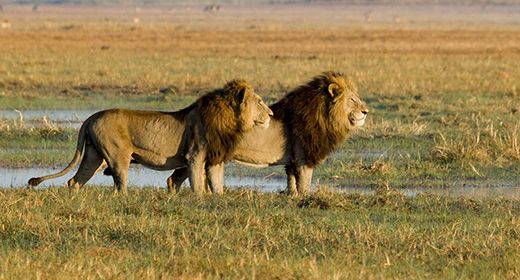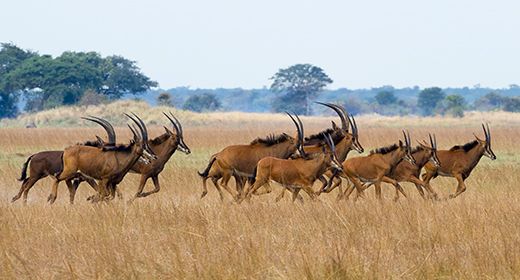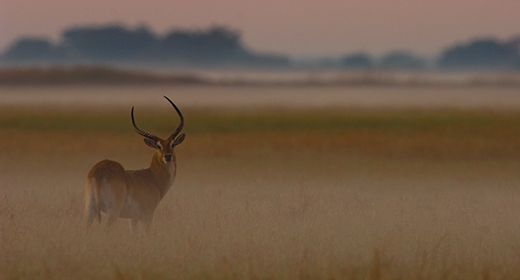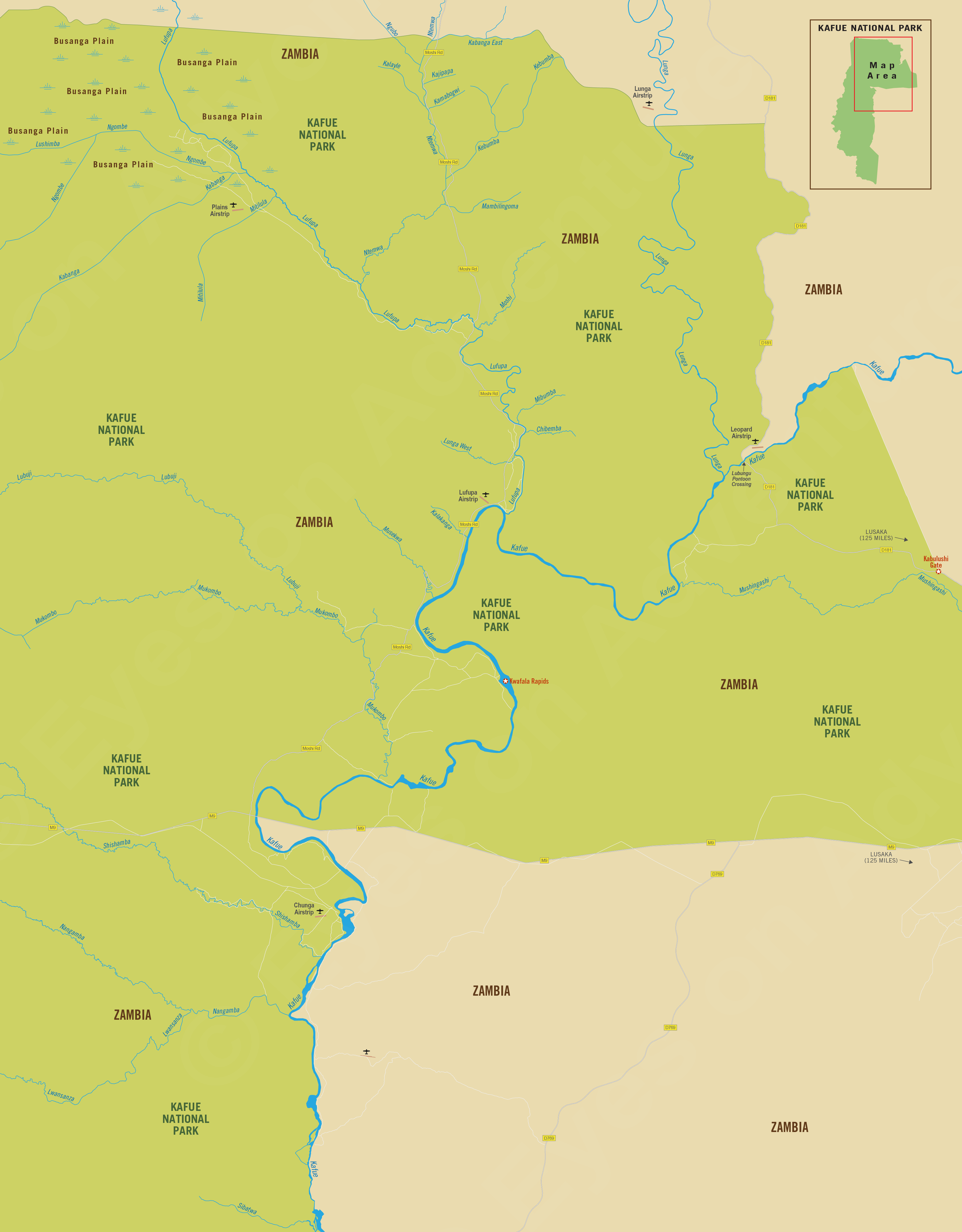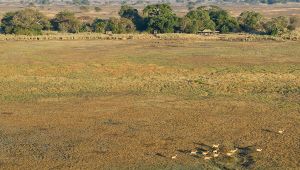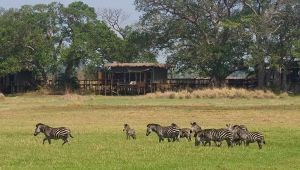Kafue
(incl. Busanga Plains, Kafue National Park)
Region Links: Kafue, Livingstone, Lower Zambezi (Zambia), North Luangwa, South Luangwa
Highlights
- Africa's second-largest National park
- Huge diversity of wildlife and habitats
- Busanga floodplains offer seasonally spectacular wildlife viewing
- Very few safari camps and low tourist numbers
EOA Recommends: Busanga Bush Camp, Shumba Camp
Kafue is Zambia's largest national park and, although a seasonal destination, offers an exceptional safari experience, with diverse habitats, abundant wildlife, and seemingly endless expanses of wilderness.
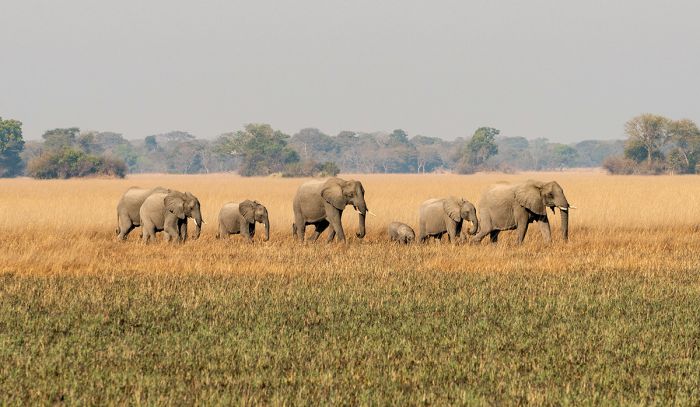
Elephants crossing a floodplain in Northern Kafue
Kafue is mostly undeveloped, but the northern half of the park offers the best experience, especially in and around the Busanga Plains. There are only a small number of safari lodges in this immense reserve, so guests will enjoy a feeling of having the place to themselves.
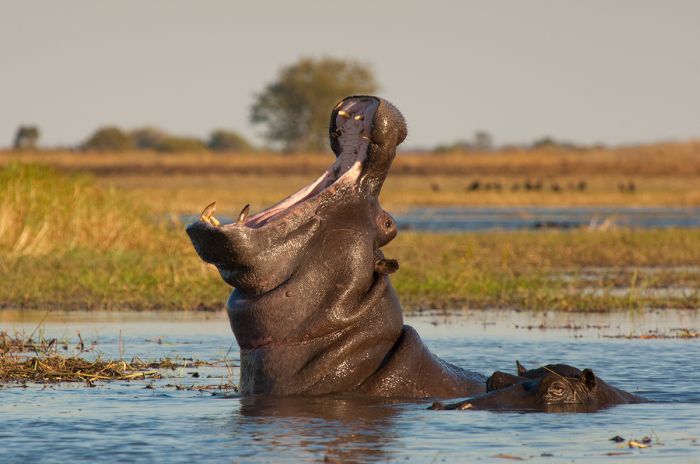
A hippo gives warning in Busanga's permanent swamp (Copyright © James Weis)
The Busanga area is a mix of permanent swamps bordering vast, seasonally flooded grasslands. During the dry months, these floodplains are home to herds of buffalo, red lechwe, puku, hartebeest, zebra, and wildebeest. Predators including lion, leopard, cheetah, and spotted hyena are found throughout the north of the park and wild dog are seen as well. Elephants are present in moderate numbers.
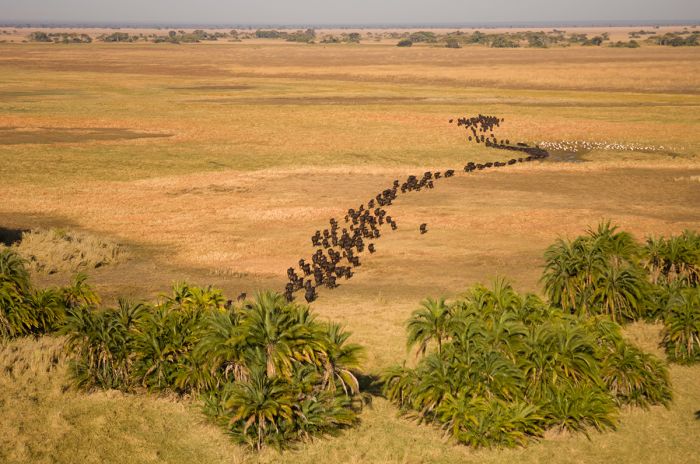
A herd of buffalos moving through the Busanga Plain (Copyright © James Weis)
The Kafue River flows through Northern Kafue and numerous tributaries, including the Lunga and Lufupa Rivers, create rich riparian habitat for wildlife. Away from the rivers there are patches of miombo woodland, bushy thickets, open grasslands, and palm islands.
For wildlife enthusiasts that prefer to be away from the crowds, Kafue offers a superb safari adventure in a pristine and remote wilderness.
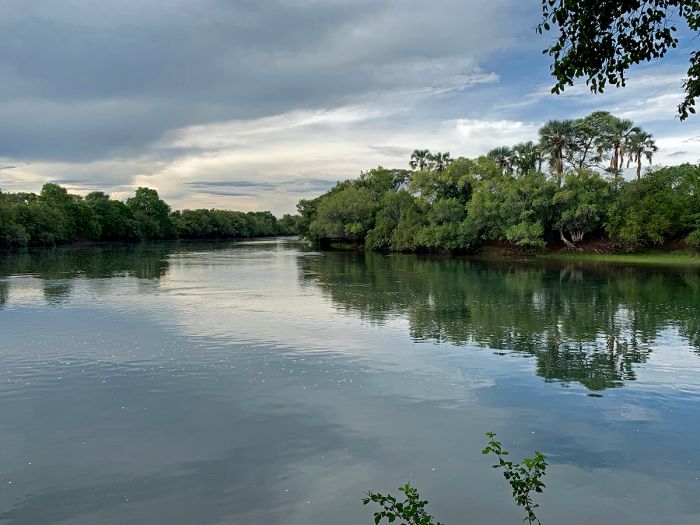
A view of the Kafue River
Read More...
Busanga Plains, Geography, History, Kafue River, Poaching, Southern Kafue, Wildlife
History
The early human inhabitants of North and Central Zambia are referred to as the Khoisan, who were hunter-gatherers. Sometime around 300 AD, Bantu-speaking people began migrating from the north and settling in the area, eventually assimilating or displacing the Khoisan. Large waves of Bantu people arrived beginning in the 12th century, including the Tonga and Nkoya people.
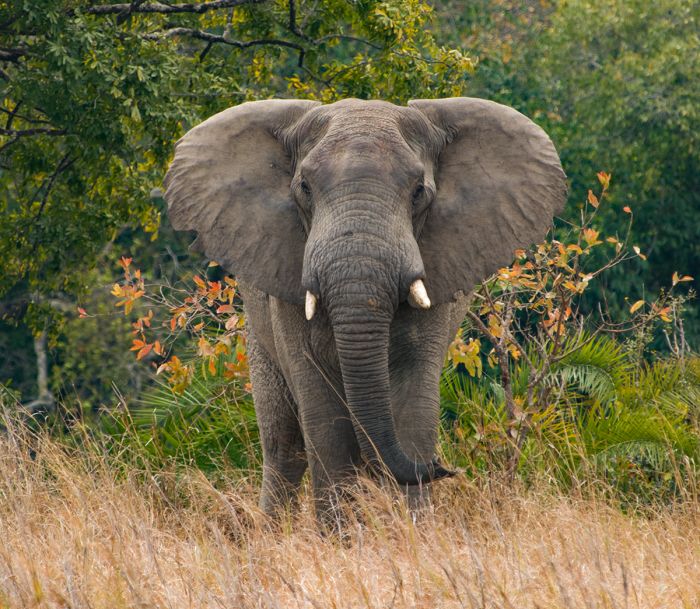
A bull elephant in Kafue National Park (Copyright © James Weis)
In 1888, the British South Africa Company, which was led by Cecil Rhodes, obtained mineral rights from the local Lozi people and thus began Britain's colonization of present day Zambia. In 1924, administration of the land that is present-day Zambia transferred to Britain and it officially became a British Protectorate called Northern Rhodesia.
In 1924, the Kafue Game Reserve was created to stem the continued decline of wildlife populations in the Kafue Basin. The reserve at that time only included the northern portion of what is today the national park. Unfortunately, because there was no official conservation arm of government in those days, wildlife populations continued to decrease and the reserve was unsuccessful.
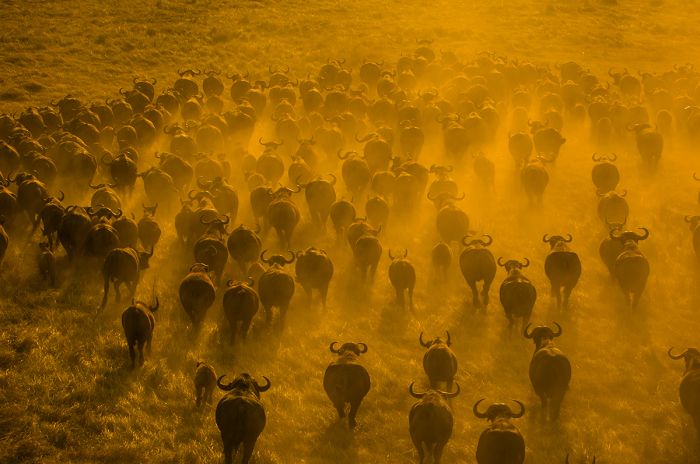
Herds of buffalo are found in Northern Kafue (Copyright © James Weis)
In 1949, the land comprising the southern half of what is today the national park (which was then a cordon controlled area) was added to the reserve. In 1950, the expanded reserve was officially proclaimed as Kafue National Park (KNP). Norman Carr was the first official Warden of KNP.
Human settlements of the Bantu-speaking Nkoya people, which were scattered sparsely within the new national park's boundaries, were relocated outside the park's borders.
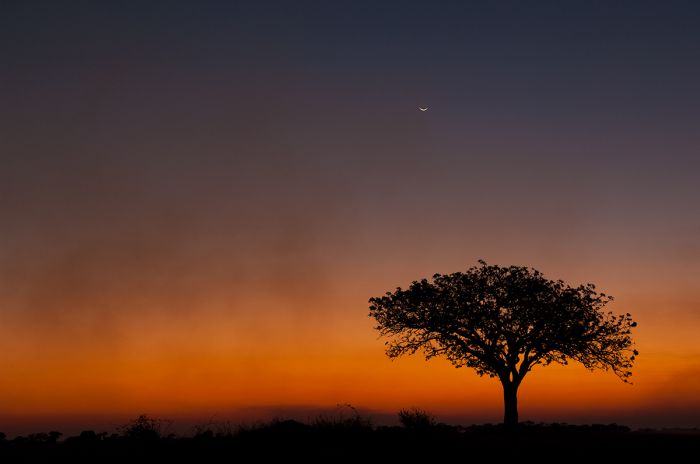
Sunset on the Busanga Plains, Kafue National Park (Copyright © James Weis)
Poaching
The huge demand for elephant ivory and rhino horn in Asia during the 1970s and 1980s led to a sharp rise in poaching in Zambia's wildlife areas, including the Luangwa Valley and Kafue Basin.
Unlike other Southern African countries like Botswana, which initiated "shoot-to-kill" policies for its anti-poaching law enforcement, Zambia dedicated few resources to combatting poaching, and so organized commercial poaching was rampant.
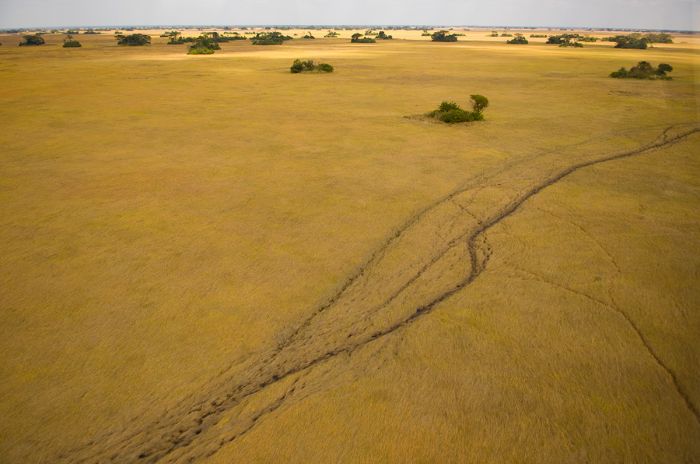
Game trails through the Busanga Plains (Copyright © James Weis)
The poaching groups were often armed with automatic weapons, and they decimated Zambia's elephant and rhino populations in its national parks, including Kafue. Luangwa was hit the hardest and Kafue was badly affected as well, but because of its relative inaccessibility, poaching in Kafue was not on a scale as large as Luangwa.
Kafue's elephants, which once numbered an estimated 60 000 in the 1960s, were nearly exterminated from the park by the late 1980s. Today Kafue is home to around 4 000 elephants. Kafue also once had one of Africa's largest populations of black rhinos, but sadly, all of Kafue's rhinos were poached during the 1980s.
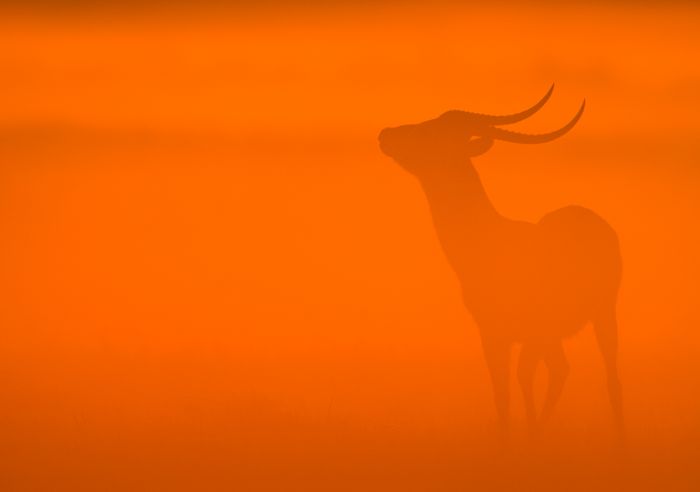
A red lechwe in dawn fog, Kafue National Park (Copyright © James Weis)
Poaching in Kafue is uncommon today and only occurs on a small scale and typically for food. The Zambia Wildlife Authority (ZAWA) conducts anti-poaching patrols in the park and the presence of safari camps reduces the threat, especially in the northern portion of Kafue.
Geography
Kafue National Park spans 8 650 square miles (22 400 sq kms), making it Zambia's largest, Africa's second largest, and one of the world's largest national parks. It gets its name from the lengthy Kafue River, which flows through the northern portion of the park. The park is surrounded by Game Management Areas on all sides, providing important buffer zones.

The wildlife-rich Lunga River in Northern Kafue (Copyright © James Weis)
Northern Kafue contains a variety of habitats, with the dominant vegetation being miombo woodland, which refers to various semi-deciduous trees, including the 'miombo' tree (Brachystegia genus). Patches of riparian teak forest and bushy thickets also occur along the rivers. Elsewhere are belts of mopane tree woodland.
Several significant waterways flow through Northern Kafue, the largest of which gives the park its name. Besides the Kafue River, which winds south through the park and eventually joins the Zambezi River, the Lunga, and Lufupa Rivers, are significant waterways that join the Kafue in the northern portion of the park.
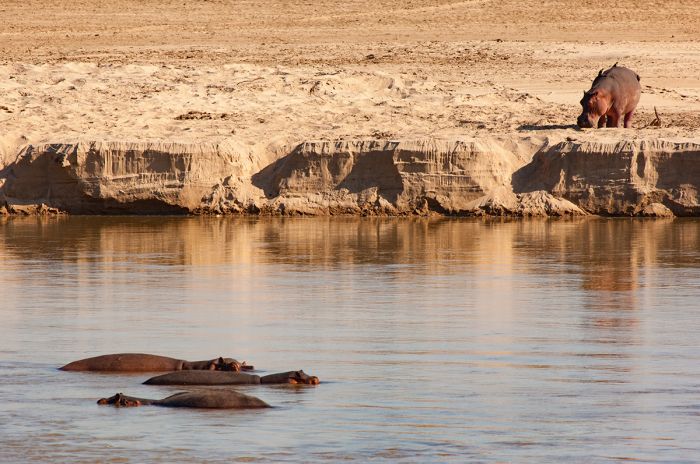
Hippos in the Kafue River (Copyright © James Weis)
Busanga Plains
Seasonally flooded grasslands adjoin some of the park's rivers and their smaller tributaries (locally called 'dambos'). The largest and most important of the seasonally inundated floodplains are the Busanga Plains, which border the Lufupa River in the far northwest of the park. These floodplains cover a vast area of over 230 square miles (600 sq kms). The Busanga only start to dry up around June and in some places remains wet all year.
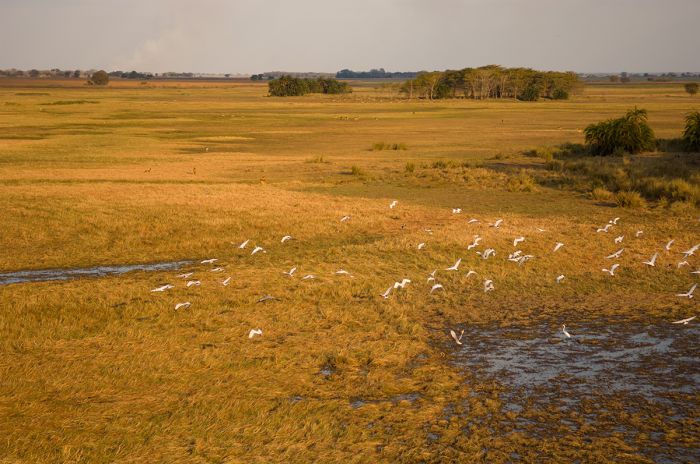
View over the Busanga Plains in July (Copyright © James Weis)
The seasonal flooding and rich black-cotton soil creates important grazing habitat for wildlife, with water present to some degree even during the drier winter months. During the rainy season, these dynamic floodplains are only accessible by boat and become crucial habitat for birds and hippos.
Open grassland plains, interspersed with small 'tree islands' are present throughout the Busanga. These islands typically begin as termite mounds, with seeds left by birds then germinating on the elevated ground and eventually expanding with various trees including wild date palms, Phoenix palms, sycamore figs, and baobabs. This scenery is reminiscent of many areas in Botswana's Okavango Delta.
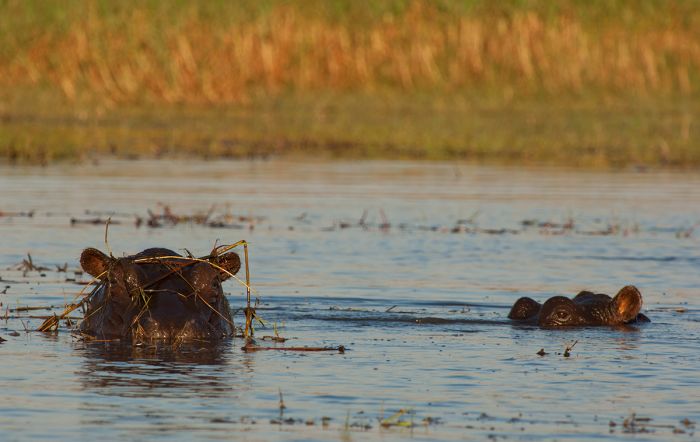
Hippos enjoy lasting floodwater in Busanga (Copyright © James Weis)
Kafue River
The Kafue is Zambia's longest river at 990 miles (1 600 kms) long and is entirely contained within the country. Beginning in a plateau region in the far north of the country, near the border with DRC, the Kafue River flows through the north and central portions of Kafue National Park, before entering the man-made Itezhi-Tezhi Dam and then flowing east to the border with Zimbabwe, where it joins the Zambezi River.
The Kafue River basin includes a multitude of tributaries within the park, the most substantial of which include the Lufupa, Lunga, and Mukombo. Having flowed for a long distance before reaching the national park, the Kafue's deep and wide waters are a perfect aquatic environment for the large numbers of crocodile and hippo that live in the park.
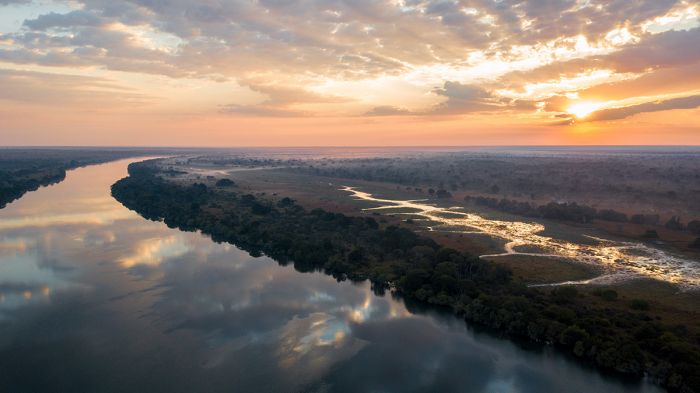
Sunset over the Kafue River
The Kafue River is also a favorite haunt for the park's elephants and buffalo, which feed along its banks and on the various small islands along its course. At Kwafala there is a stretch of gentle rapids where the river widens to around 3 300 feet (1 km).
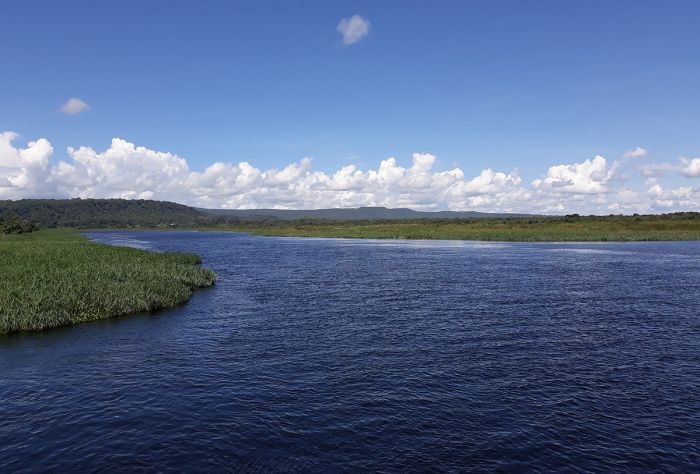
The blue waters of the Kafue River
Southern Kafue
The southern half of Kafue is dominated by Kalahari sands and is therefore quite different from the northern half of the park. It is generally more arid the further south one goes, and includes vegetation and woodlands typical of the Kalahari, with patches of mature teak and cathedral mopane tree forests.
The wildlife in the south is much more scarce and skittish than in the north (due to small-scale poaching pressure), but there are good populations of impala, wildebeest, eland, elephant, buffalo, puku, greater kudu, Lichtenstein's hartebeest, waterbuck, warthog, and baboon. Roan and sable antelopes are also present.
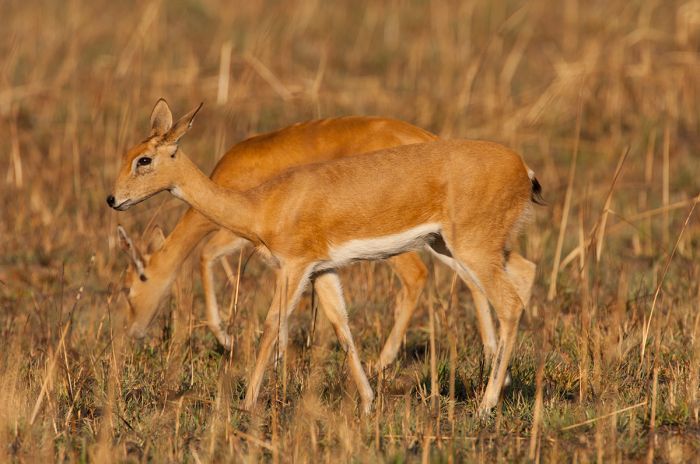
Oribi antelope are found throughout Kafue National Park
Wildlife
Kafue's huge area and its variety of habitats including rivers, grasslands, floodplains, forests, and permanent swamps, make it ideal for an abundance and high diversity of wildlife.
The Busanga floodplains provide particularly rich habitat for grazers and it is one of the best places in the park to see big herds of red lechwe, puku, roan antelope, and buffalo. Smaller numbers of zebra and wildebeest are also present in Busanga. The permanently flooded areas around Busanga are home to the shy sitatunga antelope, which has evolved to live in these swamps.
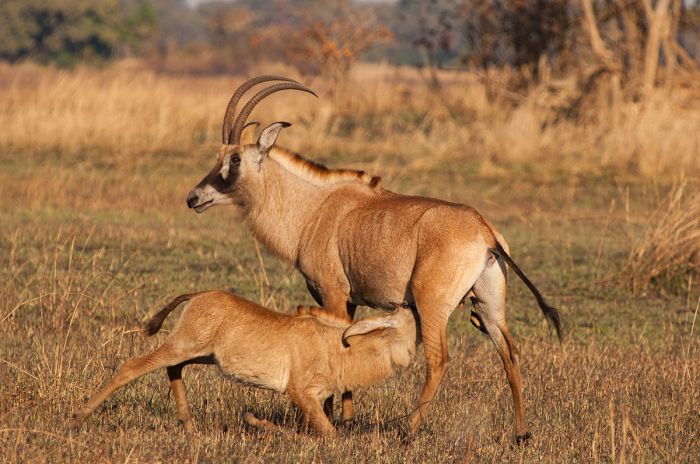
A roan antelope and her calf (Copyright © James Weis)
Kafue's forested and mixed bush/scrub habitats are favored by greater kudu, bushbuck, eland, Lichtenstein's hartebeest, sable antelope, defassa waterbuck, grysbok, and duiker. Puku are the most abundant antelope in Northern Kafue and impala only become common in Southern Kafue. Oribi, a diminutive antelope, can be found throughout Kafue.
Kafue also boasts a good variety of predators. Lions are widespread and commonly seen throughout the park, but especially in the Busanga area. Leopards are common but somewhat elusive, staying primarily in the wooded areas along the waterways. Spotted hyenas are also fairly common, but not in large groups and are commonly seen in the open grasslands and scrub.
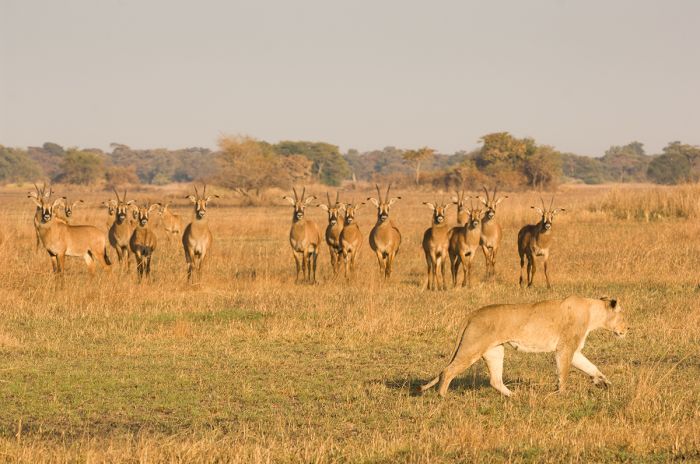
A herd of roan antelopes watch a lioness (Copyright © James Weis)
Cheetah are uncommon in the park generally, but are doing very well in the Busanga Plains and this is the best place in Zambia to see these beautiful cats. Kafue's large area and abundance of prey like puku and impala, make it Zambia's best locale for seeing African wild dogs. Packs are often sighted in the Busanga plains.
Elephants are seen throughout Kafue, but numbers are still recovering from the rampant poaching of the 1970s and 1980s. Breeding herds, small groups of bulls, and solitary bulls can be encountered anywhere in the park, but especially along the major rivers and in the Busanga Plains.
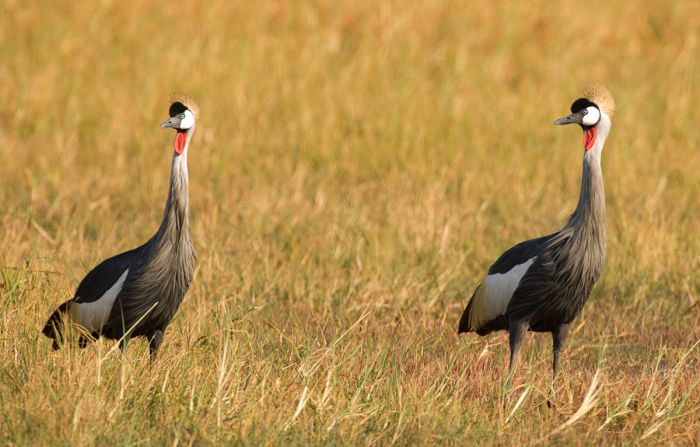
Crowned cranes are fairly common in Kafue NP (Copyright © James Weis)
Kafue's numerous rivers are unspoiled and offer superb habitat for fish, otters, and other aquatic life. Hippos are crocodiles are common in the deeper waters of the Kafue, Lunga, and Lufupa Rivers.
Kafue's primates include yellow baboons and vervet monkeys, both of which are common and found throughout Kafue.
Birding in Kafue is very good, with over 500 species recorded. The seasonal floodplains are especially good for wattled and crowned cranes, as well as a huge host of water-dependent and plains birds.

A vervet monkey enjoys a fig in Kafue (Copyright © James Weis)
Read More...
Busanga Plains, Geography, History, Kafue River, Poaching, Southern Kafue, Wildlife
Great Good Fair Poor
- Jan
- Feb
- Mar
- Apr
- May
- Jun
- Jul
- Aug
- Sep
- Oct
- Nov
- Dec
Northern Kafue is a seasonal destination, with portions of the national park, in particular the Busanga Plains, becoming inaccessible during the rainy season between November and May. The roads in Busanga become inundated with water during this time and the camps are only open during the dry season months (Jun-Oct).

Red lechwe in Busanga during July (Copyright © James Weis)
Further south from the Busanga, in the more central region of Kafue are camps that remain open year-round, even during the 'green season' between November and May.
Wildlife viewing is best during the dry, winter months, when the Busanga becomes a grazing haven for big herds of buffalo, red lechwe, puku, roan, and more. The riparian forests and the rivers attract wildlife as the surrounding plains begin to dry out.
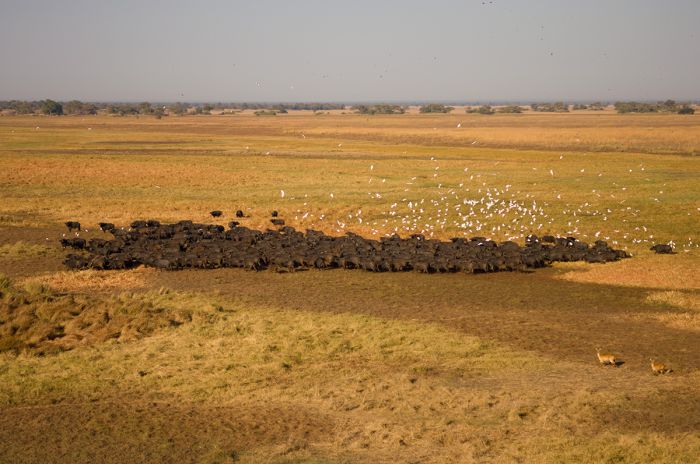
Buffalo on the Busanga Plains in Kafue National Park (Copyright © James Weis)
Winter / Dry Season
May through October is the dry season in Kafue and this is the best time to visit. Rainfall is rare to nonexistent, the days are warm and nights are chilly. Layered clothing, including a fleece is recommended for the early morning game drives.
June marks the end of the rains. June and July are the coolest months, with daytime temps averaging 75-78°F (24-25°C) and nights dropping to 40-45°F (4-7°C).
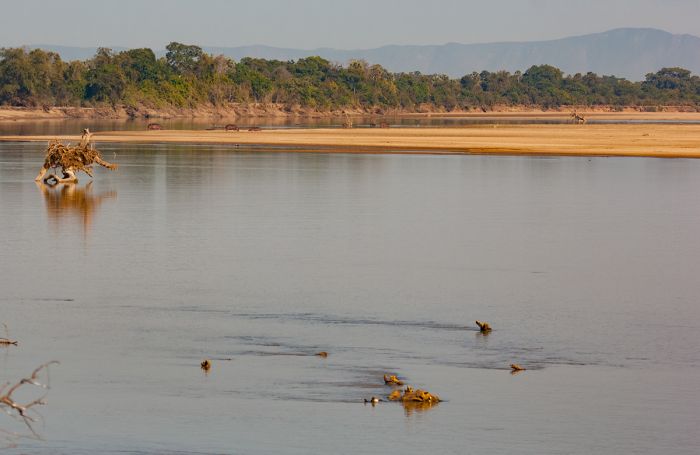
Hippos on the banks of the Kafue River in winter (Copyright © James Weis)
August and September are prime game viewing months. The landscape becomes dry in most places, although the rich Busanga Plains still hold water, making it an outstanding place for wildlife. Temperatures warm up slightly, averaging daytime highs of 85-90°F (29-32°C). Overnight temps average 50-55°F (10-13°C).
October is hot and dry, with excellent game viewing. Temperatures climb to 89-93°F (32-34°C) during the day and nights are comfortable at 58-63°F (14-17°C). Early rains are possible at the end of October.
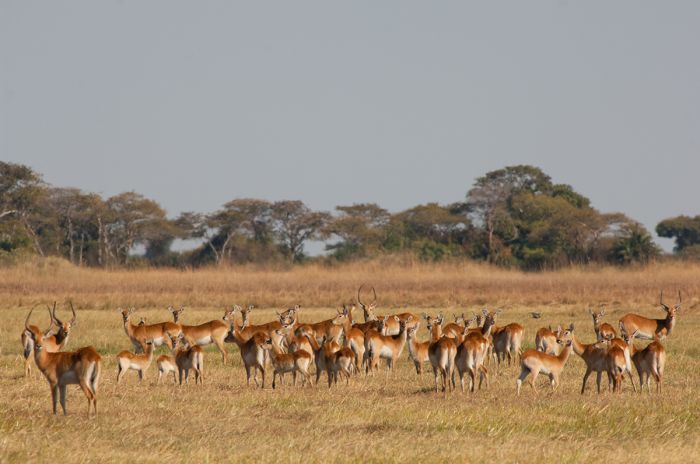
Red lechwe in Kafue National Park during winter (Copyright © James Weis)
Summer / Rainy Season
November through May is the rainy season in Kafue. Safari camps in the Busanga Plains region are closed, as the area becomes flooded and the roads submerged. Camps away from Busanga may remain open all year. December thru February receives the most rain.
November (sometimes late October) marks the onset of the rains, which brings welcome relief to the dry land. Temperatures cool off once the first rains arrive. Daytime temps average 84-87°F (29-31°C) and overnight temps fall to 55-57°F (13-14°C). The early rain typically occurs as afternoon thunderstorms every few days.
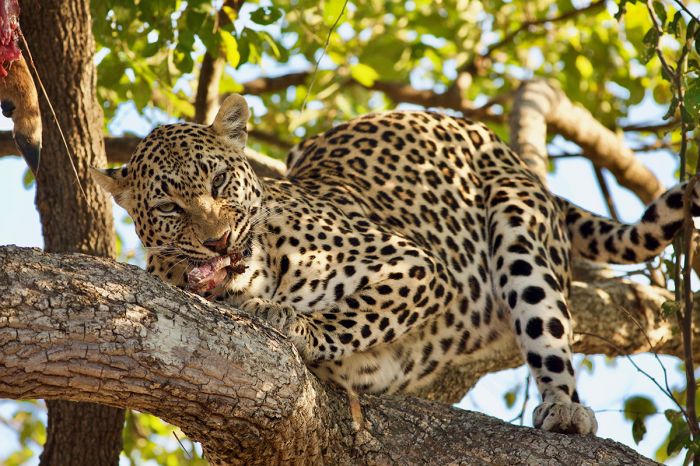
A leopard with a meal in Kafue National Park
December through March experience the most rainfall, with daily showers the norm, but rarely occurring as all-day rain. Temperatures average 79-83°F (26-28°C) during the day and fall to a comfortable 62-65° (17-18°C) overnight.
April and May are the end of the rainy season, with lush, green landscapes and rainfall occurring only sporadically. The roads in Busanga are still submerged and can be difficult throughout Northern and Central Kafue. The days are lovely, with temps averaging 80-84°F (27-29°C) and the nights still comfortable with temps averaging 55-60°F (13-15°C).
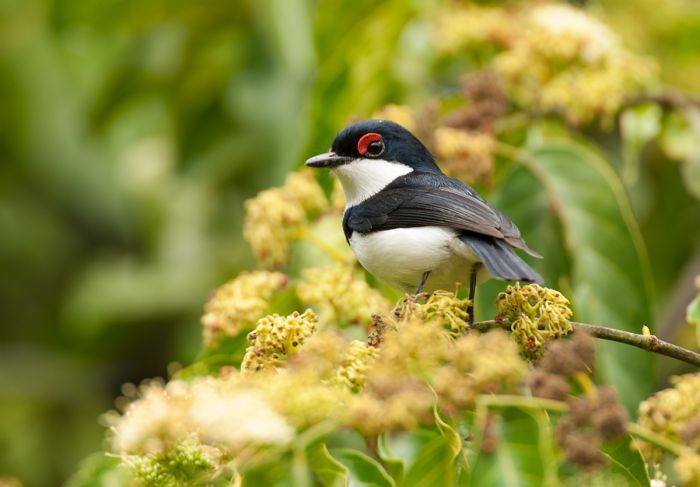
A black-throated wattle-eye along the Lunga River (Copyright © James Weis)
Showing 1–2 of 2 results
Small, classic-style tented camp located in the remote wilderness of northern Kafue in a dynamic wetland called the Busanga Plains. Offers seasonally superb wildlife viewing via game drives and boating. Open Jun-Oct.…




